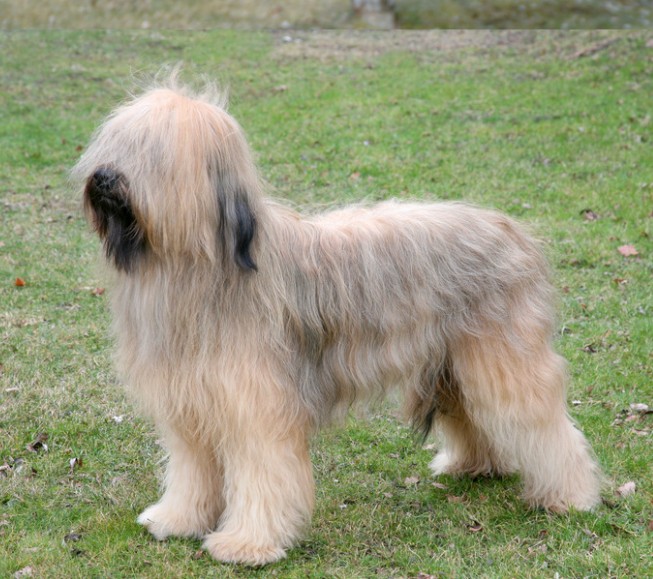Introduction
Picture a dog with the heart of a medieval knight and the soul of a devoted shepherd, wrapped in a flowing coat that seems to ripple with every purposeful stride. The Briard, or Chien Berger de Brie as it’s known in its native France, carries within its genes over twelve centuries of European history. From the pastoral fields of medieval Brie to the trenches of World War I, where they served as sentries and ammunition carriers, these remarkable dogs have stood alongside humanity through triumph and tragedy alike.
What makes the Briard truly extraordinary isn’t just their striking appearance—though those flowing locks and soulful eyes certainly capture attention—but rather their unique dual heritage as both herder and guardian. Unlike breeds developed for singular purposes, Briards evolved to seamlessly shift between collaborative daytime herding and independent nighttime protection. This duality created dogs of remarkable intelligence and sensitivity, capable of making autonomous decisions while maintaining deep emotional connections with their human partners. Did you know that Napoleon Bonaparte himself owned a Briard, and the breed appears in tapestries dating back to the 8th century?
Today’s Briard remains true to its ancestral calling, whether working sheep on modern farms or serving as therapy dogs in hospitals. They’ve been described as “hearts wrapped in fur”—a phrase that captures both their emotional depth and their occasionally overwhelming devotion. Let us guide you through understanding these complex, magnificent dogs, helping you discover whether a Briard might become your next loyal companion 🧡.
Character & Behaviour
The Herder-Guardian Duality
Understanding the Briard means appreciating how centuries of dual-purpose breeding shaped their psychological architecture. During daylight hours, medieval French shepherds needed dogs capable of moving large flocks across vast territories, requiring collaboration, responsiveness, and tactical thinking. But when darkness fell, those same dogs transformed into autonomous guardians, patrolling perimeters and making independent decisions about threats without human guidance.
This historical duality manifests in modern Briards as a fascinating behavioral dichotomy. You might notice your Briard displaying intense focus during structured activities—whether that’s obedience training or simply following you during household chores—yet shifting to independent decision-making when they perceive potential threats. They don’t simply react; they evaluate, assess, and choose responses based on complex threat calculations developed over centuries. This isn’t stubbornness but rather the expression of genetics that prioritized thinking dogs over blindly obedient ones.
The breed’s distinctive “wait and watch” approach reflects their guardian heritage. Unlike breeds that bark at every stimulus, Briards conserve energy while maintaining perpetual environmental awareness. They position themselves at vantage points—often doorways or elevated surfaces—where they can monitor multiple zones simultaneously. This vigilance appears relaxed to casual observers, but experienced Briard owners recognize the constant processing happening behind those watchful eyes. Your Briard isn’t being lazy when lying by the door; they’re actively cataloging every sound, scent, and shadow, ready for explosive action if circumstances demand 🧠.
Emotional Intelligence and Family Bonds
The phrase “hearts wrapped in fur” perfectly captures the Briard’s profound emotional capacity. These dogs don’t merely live alongside their families—they become woven into the emotional fabric of the household, displaying what many owners describe as empathetic responses that border on supernatural. Your Briard will likely know you’re getting sick before you do, positioning themselves closer than usual, offering gentle comfort through subtle presence rather than demanding attention.
With family members, Briards exhibit loyalty that goes beyond simple attachment. They form intense, differentiated bonds with each household member, adjusting their interaction style to match individual personalities. The same dog might be gently protective with children, playfully competitive with teenagers, and quietly companionable with elderly family members. This emotional calibration isn’t trained—it’s an inherent sensitivity that makes them exceptional therapy and service dogs.
However, this same sensitivity creates vulnerability to household tensions. Briards absorb family stress like emotional sponges, potentially developing anxiety or behavioral issues in chaotic environments. Arguments between family members can trigger stress responses lasting days, while major changes like divorce or death may cause profound behavioral shifts. Supporting your Briard through family challenges requires acknowledging their emotional investment and providing extra stability during turbulent times.
Intelligence Beyond Commands
Briard intelligence transcends simple trainability metrics—these dogs demonstrate complex problem-solving abilities that often surprise even experienced owners. Their cognitive approach reflects both herding tactics and guardian strategy, combining immediate tactical responses with long-term strategic thinking. You’ll find your Briard not just learning routines but analyzing patterns, predicting outcomes, and occasionally manipulating situations to their advantage.
In herding contexts, Briards demonstrate remarkable anticipation of livestock movement, adjusting pressure and position based on subtle behavioral cues invisible to human observers. They calculate angles, predict escape routes, and modify tactics based on individual animal behavior. Modern Briards apply these same analytical skills to domestic life, often figuring out complex sequences like opening multiple door types or creating elaborate games to entertain themselves during alone time.
This intelligence requires appropriate channeling through mental challenges that respect their independent thinking. Puzzle toys that require sequential problem-solving, scent work that engages their analytical abilities, and training games that allow creative solutions all satisfy their cognitive needs. Without adequate mental stimulation, Briards may invent their own entertainment—potentially dismantling furniture to understand construction or reorganizing household items according to their own mysterious organizational systems 🐾.
Protective Instincts and Threshold Management
The Briard’s protective behavior follows a sophisticated escalation protocol developed through centuries of guardian work. Understanding this graduated response system helps owners manage and channel these instincts appropriately in modern settings. Initial warnings involve subtle positioning—your Briard places themselves between family and perceived threats, using body blocking rather than aggression. This silent intervention often goes unnoticed by guests but represents the first level of protective response.
If initial positioning doesn’t deter threats, Briards escalate to visual intimidation through intense staring and raised hackles, making themselves appear larger and more formidable. The deep, resonant bark that follows—distinctly different from excitement or play vocalizations—serves as an auditory warning designed to intimidate without requiring physical intervention. Most situations resolve at this level, with the Briard maintaining defensive positioning until they determine threats have passed.
Physical intervention represents their final option, typically involving charging and body-slamming rather than biting. This restraint reflects selective breeding for guardians who could deter predators and thieves without causing unnecessary injury to valuable livestock or people. Modern Briards retain this measured approach, though socialization significantly influences their threat assessment accuracy. Working-line dogs may display lower threat thresholds, beginning defensive sequences at greater distances, while well-socialized show-line Briards might only react to direct territorial intrusions.
Training & Education
Foundation Through Early Socialisation
The critical importance of early socialisation cannot be overstated for Briards—these naturally reserved and protective dogs require extensive positive exposure during their first 16 weeks to develop appropriate social calibration. Your Briard puppy needs systematic introduction to at least 100 different people, with special emphasis on categories they’ll encounter throughout life: children of various ages displaying unpredictable movement, elderly individuals with different gaits and mobility aids, delivery personnel in uniforms, and people of diverse ethnicities and appearances.
Beyond human exposure, environmental conditioning shapes lifelong confidence. Urban-raised Briards need deliberate exposure to farm animals, while rural puppies require intensive urban conditioning to prevent adult reactivity to city stimuli. Traffic sounds, sudden noises, crowded spaces, and unusual surfaces all need positive association during this critical window. Creating “socialisation field trips” where puppies experience novel environments while receiving treats and praise builds resilience against future stress.
The breed’s guardian instincts make dog-to-dog socialisation particularly crucial. Without proper early exposure, adult Briards may display excessive controlling behavior toward other dogs, attempting to herd or dominate rather than play appropriately. Controlled playgroups with stable adult dogs teach appropriate communication, while exposure to various play styles helps them differentiate between normal dog behavior and genuine threats. Remember that socialisation isn’t just exposure—it’s creating positive associations that counter their natural wariness 🧡.
Working With Sensitivity and Intelligence
Training Briards requires understanding their unique combination of intelligence, sensitivity, and independent thinking. These aren’t dogs that respond well to drilling or harsh corrections—their sensitive nature means punitive methods often trigger shutdown or defensive responses that damage the training relationship. Instead, successful Briard training builds on their problem-solving abilities and desire for partnership when treated with respect.
Positive reinforcement frameworks work exceptionally well, but require creativity to maintain engagement. Simple repetition bores intelligent Briards quickly, leading to creative non-compliance or outright refusal. Instead, vary exercises within sessions, building complex behavior chains that challenge their cognitive abilities. For example, rather than practicing “sit” repeatedly, create sequences where sit leads to stay, then to recall, then to specific position changes, maintaining mental engagement throughout.
Their independent heritage means Briards often pause to consider commands before compliance, especially if requests seem arbitrary or contextually inappropriate. This isn’t defiance but rather the expression of genetics that valued thinking dogs over automatic obedience. Patience during these processing moments, combined with consistency in expectations, helps Briards understand when independent decision-making is appropriate versus when immediate compliance is required.

Channeling Guardian Instincts
Rather than suppressing protective behaviors—an impossible and potentially dangerous goal—successful Briard ownership involves channeling these instincts into manageable expressions. Teaching controlled alert behaviors allows your Briard to fulfill their guardian role while maintaining household peace. Start by establishing a “watch” command that gives permission to alert, paired with a “enough” or “quiet” command that signals the end of guardian duty.
Threshold training proves essential for managing territorial responses. Practice calm behavior at property boundaries through graduated exposure and reward for relaxation. Begin with low-intensity stimuli at distance—perhaps a friend walking past your property—rewarding calm observation without reaction. Gradually increase intensity and proximity as your Briard learns that not every boundary approach requires defensive response. This systematic desensitization calibrates their threat assessment without eliminating protective capability.
Structured stranger introductions create protocols for accepting visitors while maintaining guardian awareness. Teach your Briard a greeting routine: they must maintain a designated position (perhaps a specific mat or bed) while guests enter, only approaching after release. This provides structure during potentially triggering situations while allowing them to fulfill their monitoring role. Many Briards learn to differentiate between “invited guests” who follow introduction protocols and genuine intruders who don’t, maintaining protection while enabling social household functioning.
Advanced Training for Mental Stimulation
Briards excel at advanced training that engages their problem-solving abilities and working heritage. Scent work particularly suits their methodical thinking and independent work style. Starting with simple “find it” games using treats, progress to searching for specific scented objects hidden throughout your property. The systematic searching required satisfies their patrol instincts while providing intense mental stimulation that tires them more effectively than physical exercise alone.
Trick training that builds on natural behaviors keeps sessions engaging while strengthening the human-canine bond. Teach your Briard to differentiate between family members’ belongings, fetching specific items on command. This practical application of discrimination training provides mental challenge while creating useful household behaviors. Many Briards learn 50+ distinct object names, demonstrating their considerable cognitive capacity when properly motivated.
Herding training, even for companion Briards, connects them with their heritage while providing ultimate mental and physical challenge. Many Briards who’ve never seen sheep display remarkable instinct when first exposed to livestock, suggesting the power of genetic programming. Even without access to sheep, games like Treibball (urban herding using exercise balls) satisfy herding drives while teaching precision, impulse control, and handler focus 🧠.
Noble. Watchful. Devoted.
History forged their spirit. From medieval pastures to wartime trenches, Briards embody courage and versatility, serving as both herders and guardians with unwavering loyalty.
Duality shapes behaviour. Collaborative by day and autonomous by night, they balance responsiveness with independent judgment, reflecting centuries of dual-purpose breeding.



Vigilance defines their nature. Ever observant, they quietly assess environments from strategic vantage points, ready to shift from calm presence to decisive action in an instant.
Nutritional Recommendations
Feeding the Working Heritage
The Briard’s nutritional needs reflect their substantial size (55-90 pounds) and working heritage, requiring carefully balanced diets that support both physical structure and mental acuity. Daily caloric requirements range from 1,400-2,200 calories for companion dogs, with working Briards potentially needing significantly more. The key lies not just in quantity but in quality—these intelligent, active dogs need nutrient-dense foods that maintain steady energy without triggering hyperactivity or weight gain.
Optimal macronutrient ratios for adult Briards include 22-26% protein from high-quality animal sources, with working dogs benefiting from the higher end of this range. Fat content should range from 12-15%, providing concentrated energy while supporting their distinctive coat and cognitive function. Complex carbohydrates from sources like sweet potatoes, brown rice, or oatmeal offer sustained energy release, preventing the blood sugar fluctuations that can affect behavior and training performance.
Feeding schedules significantly impact both health and behavior. Two meals daily reduces bloat risk—a serious concern in deep-chested breeds like Briards. Morning meals should be moderate if training or activity follows, with the larger portion fed evening after exercise completion. This prevents gastric dilatation-volvulus (GDV) while ensuring adequate fuel for daily activities. Always maintain a 2-3 hour gap between meals and intense exercise, and consider elevated feeders to reduce air ingestion during eating, though this remains controversial among veterinary professionals.
Supporting Joint Health Through Nutrition
The Briard’s size and activity level place considerable stress on joints throughout their lifetime, making proactive nutritional support essential from puppyhood onward. Large breed puppy formulas with controlled calcium (1.2% dry matter) and phosphorus ratios prevent developmental orthopedic disease by regulating growth rate. Rapid growth, while seemingly desirable, increases risk of hip dysplasia and other joint problems that can affect quality of life.
Glucosamine and chondroitin supplementation should begin by age two, even in healthy dogs. Daily doses of 1,500mg glucosamine and 1,200mg chondroitin for dogs over 60 pounds provide building blocks for cartilage maintenance and repair. MSM (Methylsulfonylmethane) at 50mg per kilogram body weight offers additional anti-inflammatory benefits while providing sulfur necessary for connective tissue synthesis. These supplements work synergistically, requiring consistent long-term administration for optimal benefits.
Omega-3 fatty acids from marine sources provide powerful anti-inflammatory effects crucial for joint health. Therapeutic doses of 70mg combined EPA and DHA per kilogram body weight help manage inflammation while supporting cognitive function—particularly important for this intelligent breed. The ideal omega-6 to omega-3 ratio ranges from 5:1 to 10:1, though many commercial foods contain excessive omega-6, necessitating additional omega-3 supplementation through fish oil or algae-based supplements.
Coat and Skin Nutritional Support
The Briard’s magnificent double coat—their most distinctive feature—requires substantial nutritional support to maintain its health and appearance. Since coat comprises 95% protein, inadequate protein intake manifests quickly as dullness, increased breakage, and delayed regrowth after shedding. Minimum dietary protein of 25% from high-quality sources ensures adequate amino acids for keratin production, the primary structural protein in hair.
Essential fatty acids play crucial roles in skin barrier function and coat luster. Beyond their anti-inflammatory properties, omega-3 and omega-6 fatty acids maintain skin hydration and reduce excessive shedding. Evening primrose oil, rich in gamma-linolenic acid (GLA), particularly benefits dogs with dry or sensitive skin. Daily supplementation with a balanced EFA supplement can transform coat texture within 6-8 weeks, reducing matting tendency while enhancing the coat’s natural water resistance.
Biotin supplementation at 5mg daily significantly improves coat texture and growth rate, particularly beneficial during seasonal coat changes when Briards “blow” their undercoat. Zinc, at 120mg daily for large breeds, supports skin healing and maintains coat pigmentation—important for breed standard appearance. Vitamin E at 400 IU daily provides antioxidant protection for skin cells while enhancing coat shine. These nutrients work together, creating the stunning coat that’s been the breed’s hallmark for centuries.
Managing Digestive Sensitivities
Briards show moderate susceptibility to gastric dilatation-volvulus (GDV or bloat), a life-threatening condition requiring immediate veterinary intervention. Prevention through feeding management proves far more effective than treatment after onset. Divide daily rations into 2-3 smaller meals, avoiding single large meals that stretch the stomach. Some experts recommend elevated feeders to reduce air ingestion, though recent studies suggest this might actually increase bloat risk—consult your veterinarian for personalized recommendations.
Food selection impacts bloat risk significantly. Avoid foods listing fat or oil within the first four ingredients, as high-fat content delays gastric emptying. Limit fermentable carbohydrates like soy or brewers rice that produce gas during digestion. Foods preserved with citric acid show increased bloat risk, particularly when moistened before feeding. Maintain consistent diets, as sudden changes can trigger digestive upset that may contribute to GDV development.
Probiotic supplementation supports digestive stability in this sensitive breed. Daily administration of multi-strain probiotics containing at least 1 billion CFU helps maintain beneficial gut bacteria balance. This proves particularly important during stress, travel, or antibiotic treatment when normal flora becomes disrupted. Prebiotic fibers from sources like chicory root or pumpkin feed beneficial bacteria, creating a synergistic effect that supports both digestive and immune function 🐾.

Health Concerns
Understanding Genetic Predispositions
The Briard’s relatively limited gene pool, particularly outside France, creates certain hereditary health concerns requiring vigilant screening and management. Hip dysplasia affects approximately 11% of Briards according to OFA statistics, with multifactorial inheritance patterns complicating breeding decisions. Clinical signs include bunny-hopping gait, exercise intolerance, and progressive hindlimb muscle atrophy. Early detection through radiographic screening allows intervention before severe arthritis develops.
Congenital Stationary Night Blindness (CSNB) represents a breed-specific concern caused by RPE65 gene mutation. This autosomal recessive condition impairs vision in low light conditions, though affected dogs adapt remarkably well to familiar environments. The availability of genetic testing allows identification of carriers and affected dogs, enabling informed breeding decisions that could eventually eliminate this condition. Affected dogs can live normal lives with minor accommodations like night lights and avoiding dark, unfamiliar environments.
Progressive Retinal Atrophy (PRA) presents a more serious vision threat, causing gradual deterioration leading to complete blindness. Multiple genetic forms affect Briards, requiring comprehensive testing panels for accurate detection. Early signs include night blindness and dilated pupils, progressing to complete vision loss over months to years. While no treatment exists, affected dogs adapt well with consistent environments and owner support. Genetic testing identifies carriers, allowing breeders to avoid producing affected puppies.
Orthopedic Health Management
Beyond hip dysplasia, Briards face several orthopedic challenges related to their size and working heritage. Elbow dysplasia, affecting 4-6% of the breed, causes forelimb lameness particularly noticeable after rest. The condition involves abnormal development of elbow joint components, most commonly fragmented coronoid process. Early surgical intervention can slow arthritis progression, though many dogs require lifelong management through weight control, appropriate exercise, and anti-inflammatory support.
Panosteitis, sometimes called “growing pains,” affects young Briards between 5-18 months, causing shifting leg lameness that puzzles many owners. This self-limiting condition involves inflammation within long bones, creating acute pain that typically resolves without treatment. Management focuses on pain control and rest during acute episodes, with most dogs outgrowing the condition by two years. Understanding this temporary condition prevents unnecessary panic and expensive diagnostics in affected puppies.
Arthritis inevitably affects aging Briards, particularly those with prior joint disease. Multi-modal management combining weight optimization, controlled exercise, and pharmaceutical intervention maintains quality of life. Newer treatments like adequan injections, platelet-rich plasma therapy, and stem cell treatments offer hope for dogs not responding to traditional management. Physical therapy, including underwater treadmill work, helps maintain muscle mass supporting affected joints while providing low-impact exercise.
Endocrine System Vulnerabilities
Hypothyroidism affects 8-10% of Briards, typically manifesting between ages 4-8 years. Clinical signs often develop gradually, making early detection challenging. Weight gain despite normal appetite, lethargy, coat changes including dullness or excessive shedding, and behavioral alterations like increased anxiety or aggression may indicate thyroid dysfunction. Diagnosis requires complete thyroid panels including T4, free T4, TSH, and thyroid antibodies—single test results can be misleading.
Once diagnosed, hypothyroidism management is straightforward though lifelong. Daily thyroid hormone supplementation restores normal metabolism, with most dogs showing improvement within weeks. Regular monitoring ensures appropriate dosing as requirements may change with age or weight. The condition’s hereditary component suggests avoiding breeding affected dogs, though the exact inheritance pattern remains unclear.
Addison’s disease, while rare in Briards, presents life-threatening risks if undiagnosed. This adrenal insufficiency causes vague, intermittent signs including gastrointestinal upset, weakness, and occasional collapse. Atypical forms affecting only glucocorticoid production complicate diagnosis. ACTH stimulation testing confirms diagnosis, with treatment involving lifelong mineralocorticoid and glucocorticoid replacement. Despite the serious nature, properly managed dogs enjoy normal lifespans with excellent quality of life.
Cardiac and Neurological Monitoring
Dilated Cardiomyopathy (DCM), while not common in Briards, has been reported sporadically, with some cases potentially linked to grain-free diets. Annual cardiac screening using echocardiography identifies early changes before clinical signs appear. Early detection allows medical management that can extend quality life by years. Breeding dogs should undergo cardiac clearance to avoid perpetuating genetic predisposition.
Epilepsy affects 2-3% of Briards, typically manifesting between ages 1-5 years. The suspected genetic component hasn’t been identified, complicating breeding decisions. Seizures range from mild focal episodes with facial twitching to severe generalized tonic-clonic events requiring emergency intervention. Most affected dogs achieve good control with anticonvulsant therapy, though finding optimal protocols may require patience and adjustment.
Degenerative Myelopathy, a late-onset spinal cord degeneration, occasionally affects Briards. Genetic testing for SOD1 gene mutation identifies at-risk dogs. The condition causes progressive hindlimb weakness beginning around age 8-10, eventually leading to paralysis. While no cure exists, physical therapy and supportive care maintain quality of life during early stages. Understanding the progressive nature helps owners make informed decisions about management and eventual end-of-life care 🧡.
Attitude & Lifestyle
Exercise Requirements for Body and Mind
The Briard’s exercise needs reflect their working heritage—these dogs were bred to work all day, requiring substantial physical and mental activity to maintain psychological balance. Adult Briards need minimum 60-90 minutes of structured exercise daily, though young adults may require 2+ hours to adequately tire them. The key lies not just in duration but in variety—combining different activities prevents both physical and mental stagnation while satisfying their diverse instinctual drives.
Morning exercise sessions prove particularly important for Briards, setting a calm tone for the day ahead. A 45-minute walk incorporating training exercises, scent work, or varied terrain engages both body and mind. This isn’t just about physical exhaustion—mental engagement during exercise proves equally important. Practice directional commands, incorporate obstacle navigation, or hide treats along your route for your Briard to discover. Evening sessions can focus on different activities: perhaps swimming in summer, or indoor training games during winter months.
Working-line Briards may display almost inexhaustible energy, requiring creative exercise solutions. These dogs thrive with actual jobs—whether that’s herding, therapy work, or competitive dog sports. Without purposeful activity, they may create their own entertainment through destructive behavior or obsessive habits. Consider activities that tap into their heritage: tracking exercises satisfy their patrol instincts, while agility or herding trials channel their working drive into structured outlets.
Environmental Adaptations and Living Spaces
Rural settings provide ideal environments for Briards, offering space for natural patrolling behaviors and reduced exposure to strangers that might trigger protective responses. Acreage allows these dogs to fulfill their guardian heritage through boundary patrol while providing varied terrain for physical exercise. The lower population density reduces stress from constant vigilance, allowing more relaxed behavior than urban environments typically permit.
Suburban adaptation remains entirely possible with committed owners who understand the breed’s needs. Secure fencing reaching at least 6 feet prevents escape attempts—though most Briards respect boundaries once established. More important than yard size is how space gets utilized. Creating environmental enrichment through different textures, hiding spots for toys, and varied activity zones keeps Briards mentally engaged. Consider installing window perches allowing supervised monitoring of neighborhood activity, satisfying watchdog instincts without encouraging barrier frustration.
Urban living presents challenges but isn’t impossible for well-socialized Briards with dedicated owners. These situations require extensive early socialization to city stimuli: traffic, crowds, unexpected noises, and frequent stranger encounters. Apartment living demands creative exercise solutions and exceptional dedication to meeting activity needs. Success requires proximity to appropriate exercise areas and commitment to multiple daily outings regardless of weather or schedule constraints.
Social Dynamics and Companionship Needs
Briards function best as integral family members rather than isolated yard dogs. Their emotional sensitivity and desire for human connection mean extended isolation can trigger serious behavioral problems including destructive behavior, excessive vocalization, or escape attempts. These aren’t dogs that tolerate being relegated to outdoor-only status—they need to share living space with their people, participating in daily routines and family activities.
Multi-dog households can work well, though same-sex aggression occasionally occurs, particularly between intact individuals. Opposite-sex pairs typically prove most harmonious, especially when the Briard is raised with their canine companion. Their herding instincts may manifest as attempts to control other dogs‘ movements, which some dogs find stressful. Careful introduction and management prevents conflict while allowing natural relationships to develop.
The breed’s interaction with children depends heavily on socialization and family dynamics. Briards raised with children often display remarkable gentleness and protection, though their size can inadvertently knock over small children. Herding instincts may manifest as heel-nipping or attempts to gather running children—behaviors requiring consistent redirection. They typically differentiate between family children and visitors, showing increased vigilance around unfamiliar children that requires careful management during playdates or parties.
Grooming: More Than Maintenance
The Briard’s magnificent coat requires substantial commitment—expect to dedicate 3-4 hours weekly to grooming maintenance, with increased time during seasonal shedding. This isn’t just about appearance; proper grooming prevents painful matting, maintains skin health, and provides opportunity for bonding and health monitoring. The coat’s texture—described as “goat-like”—naturally repels dirt but readily forms mats without regular attention.
Line brushing technique proves essential for maintaining coat condition without damaging hair structure. Starting at the bottom of each section, work through small portions systematically, ensuring you reach skin level where mats typically form. Pay particular attention to friction areas: behind ears, armpits, and where legs meet body. These zones require daily attention to prevent mat formation that can quickly become painful and require professional removal.
Professional grooming every 6-8 weeks helps maintain coat manageability, though many Briard owners learn to handle basic grooming themselves. The distinctive beard and eyebrows require regular cleaning to prevent food accumulation and staining. Feet need particular attention—hair growing between paw pads must be trimmed regularly to prevent slipping and snow/ice accumulation. Many Briards enjoy grooming sessions when introduced properly from puppyhood, viewing them as bonding time rather than ordeal 🐾.
Senior Care & Graceful Aging
Adapting Exercise for Aging Guardians
As Briards enter their senior years—typically around age 7-8—their exercise needs shift rather than disappear entirely. You’ll notice your senior Briard still displaying enthusiasm for activities but requiring longer recovery periods between sessions. The spirit remains willing even as the body begins showing limitations. Adapting exercise routines to accommodate aging joints while maintaining mental stimulation becomes crucial for quality of life.
Swimming provides ideal exercise for senior Briards, offering cardiovascular benefits without joint impact. Many dogs who develop arthritis find renewed joy in water activities, maintaining muscle mass crucial for joint support. If swimming isn’t available, walking in shallow water provides similar benefits. Three or four shorter walks often suit seniors better than single long excursions, preventing overexertion while maintaining activity levels. Mental stimulation becomes increasingly important as physical capabilities decline—puzzle toys, scent work, and gentle training games keep minds sharp when bodies slow.
Watch for subtle signs of discomfort that stoic Briards might hide: hesitation before jumping into cars, choosing to lie down during previously enjoyed activities, or morning stiffness that improves with movement. These signals indicate need for veterinary evaluation and activity modification. Pain management through appropriate medications, supplements, and alternative therapies like acupuncture keeps senior Briards engaged rather than withdrawing due to discomfort.
Cognitive Health Preservation
Canine Cognitive Dysfunction affects some aging Briards, with symptoms resembling human dementia. Early signs include disorientation in familiar spaces, altered sleep-wake cycles, changed social interactions, or house-training lapses. While no cure exists, early intervention through mental stimulation and appropriate supplements can slow progression significantly, maintaining quality of life longer.
Maintaining training routines provides crucial mental exercise for aging minds. Senior Briards can learn new tricks—often showing more patience for precise behaviors than younger dogs possessed. Scent work particularly suits seniors, engaging their minds without requiring physical agility. Hide treats or familiar objects around the house, encouraging systematic searching that exercises problem-solving abilities. Even simple games like “which hand holds the treat” provide valuable cognitive stimulation.
Environmental enrichment becomes increasingly important as mobility decreases. Rotate toys weekly to maintain novelty, introduce new safe scents through herbs or essential oils, and provide visual stimulation through bird feeders or aquariums positioned for easy viewing. Social interaction with familiar dogs provides mental stimulation without physical stress. Many senior Briards enjoy simply being present during other dogs’ play, maintaining pack bonds that support emotional wellbeing through their golden years 🧡.
Conclusion: Is the Briard Right for You?
The Briard stands as a testament to centuries of purposeful breeding, creating dogs of remarkable intelligence, sensitivity, and devotion. These aren’t simply pets but partners—dogs that will share your joys, guard your home, and challenge you to become a better trainer and companion. Their dual heritage as herder-guardians creates complex personalities requiring understanding, patience, and commitment far beyond what casual dog ownership demands.
Success with a Briard requires honest self-assessment. Can you provide the extensive socialization needed to calibrate their protective instincts for modern life? Do you have 3-4 hours daily for exercise, training, and grooming? Can you appreciate a dog that thinks before obeying, sometimes deciding your commands don’t make sense in the current context? Are you prepared for a shadow following you everywhere, a guardian who never truly relaxes, and a companion whose emotional sensitivity means they’ll absorb your every mood?
For those willing to meet their substantial needs, Briards offer rewards beyond measure. Their loyalty transcends simple devotion—these dogs become integral parts of their families’ emotional landscapes. Their intelligence provides endless opportunities for learning and growth together. Their protective nature offers security that goes beyond physical guarding to emotional support during life’s challenges. The question isn’t whether Briards are remarkable dogs—history has proven that repeatedly—but whether you’re prepared to be the remarkable owner they deserve.
The future of this ancient breed depends on dedicated owners who understand and appreciate their complex nature. If you’re seeking a casual companion or decorative pet, look elsewhere. But if you’re ready for a partnership rooted in mutual respect, shared purpose, and profound emotional connection, the Briard might just be your perfect match. These hearts wrapped in fur don’t just enter your life—they transform it, teaching lessons about loyalty, purpose, and the extraordinary bonds possible between humans and dogs 🐾.










